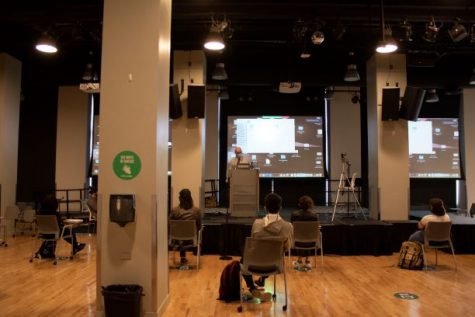‘Big Chicago,’ Columbia’s largest courses go hybrid
October 2, 2020

After taking a sabbatical last spring, Carmelo Esterrich, an associate professor in the Humanities, History and Social Sciences Department, was anxious about teaching his Big Chicago class remotely with 126 students.
“I was scared s – – – – – – – before I taught the first day,” Esterrich said. “Number one, because I had never done it. Number two, because it was 126 [students]. Number three, because these are high school students who just became college students and so I didn’t know how they were going to behave in this type of environment.”
To his surprise, Esterrich’s first two Big Chicago classes, “Latinx! Community, Culture and Citizenship,” went better than expected and his freshmen students were engaging in conversations related to course readings and other materials.
But after teaching the first two weeks remotely, some instructors of Big Chicago classes—some of the largest courses offered at Columbia—started teaching using a hybrid structure, with only one-third of students physically in class each week while the rest were online on Zoom until their week to meet in-person.
“It’s stressful just having to change the environment because I’m used to working at home now,” said Yadira Esquivel, a freshman public relations major taking Esterrich’s “Latinx! Community, Culture and Citizenship” class.
Though she prefers online courses, Esquivel said the class is new for everyone and knows that Esterrich and other teachers are trying their best to navigate hybrid instruction.
However, Esquivel said students attending the class on Zoom have a difficult time getting answers to their questions when the instructor is paying attention to the students who are in-person.
Currently, there are 46 different Big Chicago classes being taught, with 28 of these courses held completely online, 16 taught using a hybrid structure and two fully in-person.
Other instructors like Diana Gorman-Jamrozik, associate professor and associate chair of the American Sign Language Department, have both sections of her course “Did You Just Flip Me Off? Deaf People and Linguistic Diversity in Chicago” online instead of in-person or hybrid.
“I am very comfortable with designing a class online,” Gorman-Jamrozik said. “It’s just so different because I can’t see all 80 students at [one] time.”
With two classes of around 80 students each, Gorman-Jamrozik said she has been using the poll function on Zoom to keep the class interactive. Her graduate teaching assistants monitor the chat for any questions or problems that come up and offer insight into the Deaf experience.
Gorman-Jamrozik said she is not Deaf herself, but any time the class talks about Deaf culture or the Deaf experience, she has her Deaf teaching assistant, Peter Wujcik, answer questions and teach signs.
Gorman-Jamrozik said she still worries about technical issues that can halt the class because she does not have a “magic button” or “a piece of chalk” to keep it going.
Patricia McNair, associate professor in the English and Creative Writing Department, said it is her first time teaching the “Chicago: City of Stories” course. She said she thought the first class was fun, considering 120 students were crammed together on her computer screen.
“Many of them had remote classes over the last semester in their last year of high school, so they were a little bit more prepared than I think we all were last spring,” McNair said.
Along with three graduate teaching assistants, McNair said she put together pre-assigned breakout rooms of 10 students each to work on projects or discussion topics more intimately. She also had students record videos to introduce themselves to the class.
“We’re all waiting for the day when we can all be back in the same room again, but in the meantime, I think that we’re learning a lot about how interconnectivity and communication are much more flexible than we might have thought when we first got into this,” McNair said.







